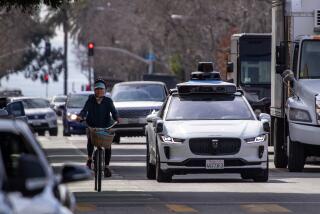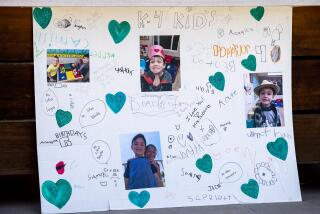Op-Ed: Texting while driving is as dangerous as driving drunk. We need to treat it accordingly
- Share via
Like many pedestrians, I’ve learned to treat Los Angeles streets as an obstacle course of distracted drivers. Rule No. 1: Make sure a vehicle is stopped or braking before stepping off the curb. But even that didn’t save me at a corner near my West Hollywood home.
The approaching car was on my right, slowing for the stop sign ahead. I started across but midway I realized the driver’s attention had drifted and her car was regaining speed, veering my way. It was too late to dodge it, so I threw myself onto the hood.
Startled, the young woman looked up from her smartphone. Texting. Of course. She braked and I rolled gingerly off her hood before she sped away. I was furious. Had I been older and less mobile, pushing a baby stroller, or preoccupied with a cellphone myself (another growing problem), her negligence might have been fatal.
Texting — the most common cause of distracted driving accidents — is fast becoming the new drunk driving. In 2015, the most recent year for which there are U.S. Department of Transportation statistics, distracted driving crashes caused 3,500 fatalities and close to 400,000 injuries. Teens are particularly at risk; they are four times more likely than older drivers to get into these accidents. One reason, according to safe driving experts: Young people, who’ve watched their parents and other adults routinely fiddle with various devices as they drive, downplay the risk.
Teens are particularly at risk; they are four times more likely than older drivers to get into these accidents.
Our legal deterrents aren’t helping. California law bans all talking, texting, or any other use of handheld mobile phones while driving. (Making emergency calls is one of the few exceptions.) With assessments and fees, convicted drivers face a first-time ticket costing at least $159, with a second offense climbing to $279. Hardly pocket change, but far below the penalties for first-time adult DUI offenders, which include fines up to $1,000, plus a minimum four-month license suspension and up to six months in jail. (Those under 21 face similar fines, possible criminal charges, and a mandatory one-year license suspension.) A conviction for driving while using a cellphone doesn’t even warrant a bump in insurance rates. That could change under Senate Bill 1030, introduced in February by state Sen. Josh Newman (D-Orange County), which would make it a one-point DMV violation that could cost drivers dearly when they renew their coverage.
Even so, enforcement of distracted driving laws seems spotty. According to the Centers for Disease Control and Prevention, one-third of drivers between the ages of 18 and 64 read or send text or email messages while in traffic. From 2011 to 2015, the National Traffic Highway Safety Administration reported an increase of cellphone-related crashes from 50,000 to about 70,000. Yet here in California, according to the CHP, the number of citations issued declined slightly in recent years from a peak of 460,000 in 2011. Experts spread the blame: budget and staffing issues at policing agencies; increased use of car speakerphones (which free the hands but still cause distraction); and officers who are reluctant to ticket a violation that’s difficult to prove in court — or for an activity many officers privately indulge in themselves.
After years of tough drunk-driving penalties and numerous public awareness campaigns, DUI-related deaths in the U.S. have declined by about a third, yet still number about 10,000 a year. Now consider the results of driving experiments conducted by Car and Driver magazine: Sober drivers who were texting or reading email took significantly longer to react to an alert than drivers with a blood alcohol content of .08, a common legal standard for intoxication. So in some situations, device-distracted driving is more dangerous than DUI. Yet in California, a driver who kills another person because of texting or talking on a handheld phone faces no more than a vehicular manslaughter charge — up to a year in jail, and possibly no jail time at all.
With the rate of smartphone ownership in the U.S. doubling from 2011 to 2018, one wonders how great the carnage will become. Will an organization as influential as Mothers Against Drunk Driving emerge to confront and stigmatize “driving while intexticated”? If not, what can bring about a meaningful cultural shift when millions of drivers are so addicted to their cellphones they’ve become oblivious to their own safety, let alone the safety of others?
Sometimes, that irresponsible driver is someone you’d least expect. Recently, I was stopped at a red light near the Santa Monica Pier. In the vehicle next to mine, the driver was riveted to his smartphone, grinning and chuckling at whatever was on his little screen. I don’t know his name, but I do know where he works — the Santa Monica Police Department. He was in uniform, at the wheel of his patrol car, using a moment stopped in traffic to get his cellphone fix.
John Morgan Wilson is a veteran journalist and award-winning fiction writer.
Follow the Opinion section on Twitter @latimesopinionand Facebook
More to Read
A cure for the common opinion
Get thought-provoking perspectives with our weekly newsletter.
You may occasionally receive promotional content from the Los Angeles Times.










